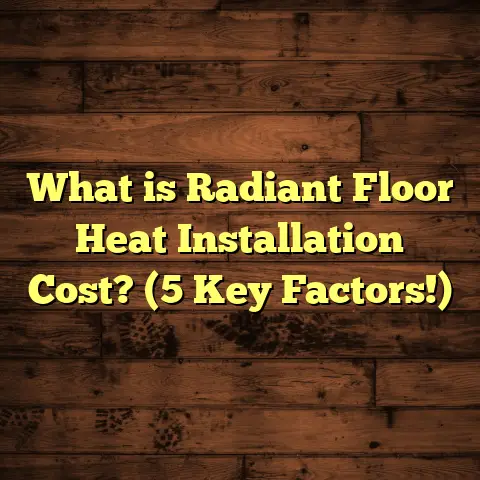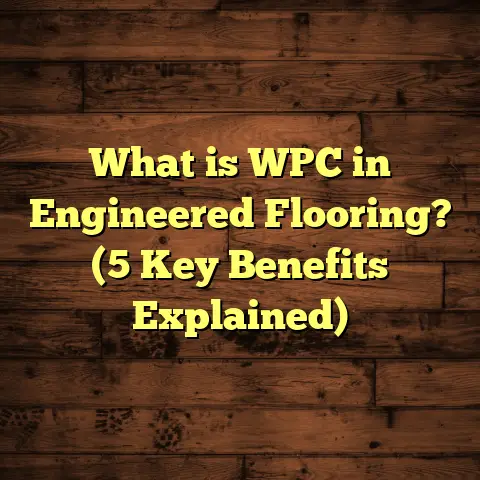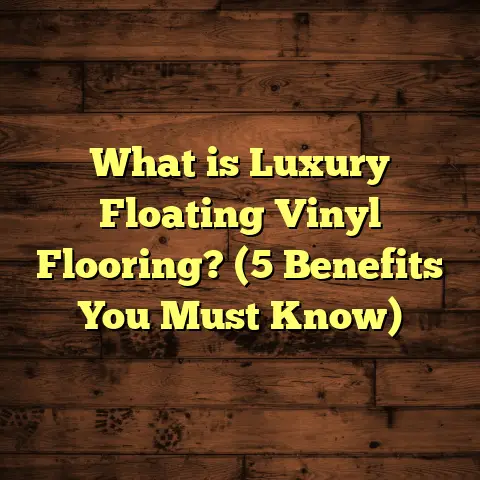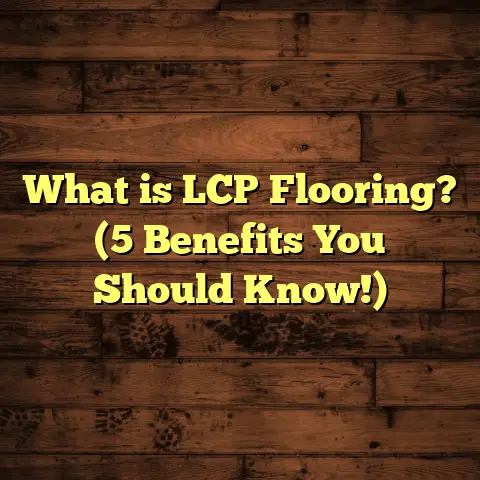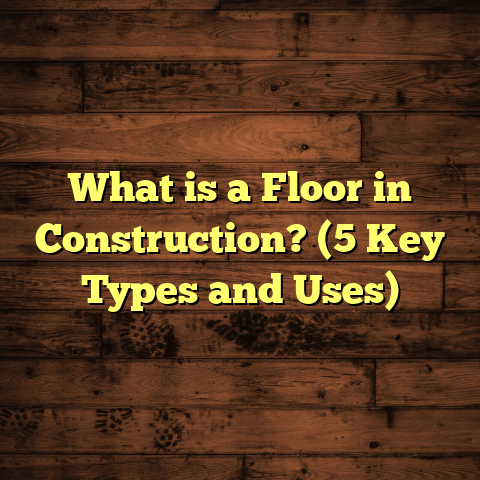What is LVT Plank Flooring Made Of? (5 Key Materials Explored)
What is LVT Plank Flooring?
Have you ever stood in a room and suddenly felt connected to the floor beneath your feet? That sense of comfort, style, and durability mixed into one surface? That’s exactly what happened to me when I discovered LVT plank flooring during my first big home renovation. I was hunting for a floor that would not only look amazing but also handle the real-life chaos of kids running around, pets scrambling, and the occasional spill without losing its charm. And that’s how I found myself fascinated by the layers and materials that make up Luxury Vinyl Tile (LVT) plank flooring.
So, what exactly is LVT plank flooring? Simply put, it’s a type of vinyl flooring designed to closely mimic natural materials like wood or stone, but with more durability and ease of installation compared to traditional options. Unlike the old vinyl sheets that were common decades ago, LVT comes in individual planks or tiles, letting you customize the look of your space with patterns or layouts that suit your taste. It’s thick, durable, and designed in multiple layers that each serve a special function — from protection to aesthetics to comfort.
I want to take you through the five key materials that form an LVT plank. Knowing what these materials are and how they work together will help you understand why LVT has become a go-to choice for homeowners and contractors alike.
1. Wear Layer: The Protective Shield
Let’s start with the top layer — the wear layer. This is the clear surface you actually walk on every day. You might not see it because it’s transparent, but it’s the reason your floor stands up to foot traffic, scratches, stains, and everything life throws at it.
The wear layer is typically made from urethane or aluminum oxide coatings. Its thickness varies widely depending on the product, ranging from about 6 mil (thousandths of an inch) for basic residential floors up to 40 mil for commercial-grade planks.
Why Thickness Matters
Think about it this way: a thicker wear layer means more protection. For example, if you have kids or pets like I do, a wear layer thinner than 12 mil might start showing scratches and scuff marks within a few months. Floors with 20 mil or more wear layers can resist scratches, dents, and stains much better over time.
Industry data shows that LVT products with wear layers of 20 mil or more tend to last up to 30% longer in high-traffic spaces compared to those with thinner layers. This translates to fewer repairs or replacements — saving you money and hassle in the long run.
My Experience
I remember installing LVT with a 12 mil wear layer in a busy office environment. Within six months, minor scratches appeared near desks and chairs. After that project, I switched to recommending floors with at least a 20 mil wear layer for office settings or active homes. Clients have been happier — fewer complaints about wear and tear, and floors looking fresh longer.
2. Printed Design Layer: The Realistic Look
Beneath the wear layer lies the printed design layer — this is where LVT gets its personality. It’s the part that replicates the look of natural wood grain, stone veining, or other textures.
This design is created using advanced digital printing technology. High-resolution images of real materials are printed onto this layer with such detail that even experts sometimes struggle to tell them apart from the real thing.
Why It Matters
The printed design layer determines how authentic your floor looks. If you’ve ever walked on older vinyl floors that scream “plastic,” you know how disappointing it can be when something looks cheap.
According to Floor Focus Magazine’s 2023 survey, over 75% of consumers say realistic appearance is their number one reason for choosing LVT over other flooring types like laminate or engineered wood.
My Personal Take
When I was shopping for flooring for my own living room, I tested several LVT brands side by side. One had a lower resolution print that looked obviously synthetic under close inspection; another had a crystal-clear oak wood grain pattern that fooled my family into thinking it was real hardwood until I spilled coffee on it! The realistic design made me confident choosing LVT over pricier hardwood options.
3. Core Layer: The Durable Foundation
Now let’s get into what gives LVT planks their strength — the core layer. This is the thickest portion of the plank and serves as the structural base keeping everything stable.
There are two main types of cores used in LVT:
- Flexible Vinyl Core: Traditional LVT is made by fusing several layers of vinyl together. This core is flexible but less resistant to dents or moisture.
- Rigid Core: This includes WPC (Wood Plastic Composite) and SPC (Stone Plastic Composite). WPC combines wood fibers with plastic for some flexibility and cushioning. SPC uses limestone powder mixed with vinyl for a very dense, hard core.
Why Choose Rigid Core?
From my years of flooring experience, I recommend SPC cores for kitchens, bathrooms, basements—anywhere moisture or temperature swings are common. SPC cores resist water better than flexible vinyl and are less likely to warp or buckle.
Data-Backed Insight
The National Flooring Association found SPC core LVT planks offer 50% better moisture resistance and 40% higher impact resistance than traditional flexible vinyl cores in real-world tests.
Real-Life Example
I installed SPC core LVT in a lakeside cabin prone to humidity changes. After two years of wet boots and fishing gear coming inside, the floor remained perfectly flat and intact—something older vinyl floors I’ve worked with rarely managed.
4. Backing Layer: Stability and Comfort
On the bottom side of each plank is the backing layer. You might overlook it since it’s hidden after installation, but this layer plays an important role in support and comfort.
Common backing materials include:
- Foam: Adds cushion underfoot and some sound absorption.
- Cork: Natural material known for excellent noise reduction and insulation.
- Vinyl: Provides waterproofing and durability but less cushion.
Why Backing Layer Matters
In apartments or multi-story homes where noise travels easily, cork-backed LVT can reduce sound transmission significantly—something my clients have loved when installing floors in upstairs bedrooms or condos.
Foam-backed floors feel softer underfoot but may compress over time in very heavy-use areas.
My Tip
If noise or comfort matters to you, don’t overlook backing options when choosing LVT products. They affect not only feel but also thermal comfort and sound control.
5. Adhesive Layer or Click System: How It All Comes Together
While technically not part of each plank’s material composition, how those planks attach to each other and the subfloor matters just as much as their layers.
Two main installation methods exist:
- Glue-down: Each plank is glued directly to the subfloor.
- Click-lock system: Planks snap together like puzzle pieces for a floating floor without glue.
Pros and Cons
Glue-down floors offer excellent stability but require more prep work and can be messy during installation. They tend to be more permanent.
Click-lock systems are popular among DIYers because they’re faster to install and allow easy plank replacement if damage occurs later.
Industry Trends
Click-lock LVT sales have grown about 25% annually over recent years due to their convenience and appeal for quick renovations.
My Installation Experiences
For commercial projects where durability is paramount, I often recommend glue-down systems to prevent movement under heavy use. For residential remodels or apartments where speed matters, click-lock has been a lifesaver—less disruption and easier fixes down the road.
Why These Materials Matter for You
Understanding these five key materials gives you insight into what makes LVT plank flooring tick—and how to pick one that fits your needs perfectly:
- If durability under heavy use is priority: look for thicker wear layers (20 mil+) and rigid SPC cores.
- For realistic looks that impress guests: prioritize high-resolution printed designs.
- Moisture-prone areas demand waterproof SPC cores plus vinyl backing.
- Noise-sensitive spaces benefit from cork or foam backing.
- Installation preferences impact cost and future repairs — click-lock offers flexibility; glue-down offers permanence.
Digging Deeper: How Manufacturers Combine These Materials
You might wonder how brands create these multilayered planks so consistently. Here’s a peek behind the scenes:
- Layer Assembly: The printed design layer is bonded to the core using specialized adhesives.
- Wear Layer Coating: A transparent protective coating is applied on top using UV curing methods that harden instantly.
- Backing Attachment: The backing material is heat-laminated or glued on bottom.
- Cutting & Shaping: Planks are precision cut with tongue-and-groove edges for click-lock systems or smooth edges for glue-down types.
- Quality Control: Each batch undergoes testing for thickness consistency, wear resistance, moisture absorption, and appearance fidelity.
Industry Standards
The ASTM International sets testing standards like ASTM F3261 which specifies minimum wear layer thicknesses and performance metrics for residential vs commercial grades.
A Closer Look at Durability: Case Study From My Projects
Let me share a detailed story from one of my recent projects involving three kids, two dogs, and a very busy household. The family needed floors that looked stylish but could handle daily spills, muddy paws, toy drops, and heavy foot traffic without losing their charm.
We decided on an LVT product featuring:
- A 20 mil urethane wear layer
- High-resolution oak print design
- SPC rigid core
- Cork backing for noise reduction
- Click-lock installation for easy maintenance
One Year Later
After twelve months, their floor showed no visible scratches or stains despite frequent abuse from kids’ activities and pet accidents. Cleaning was effortless using just mild soap and water—no special products needed.
The family told me how relieved they were not having to worry about permanent damage like they did with their previous hardwood floors, which often warped near entrances or got scratched easily by dogs’ nails.
Exploring Additional Materials Often Found in Premium LVT Products
Some manufacturers add special components inside their LVT planks to enhance performance further:
UV-Cured Coatings
Certain premium lines employ UV-cured coatings on top of the wear layer that increase scratch resistance by up to 50% compared to standard urethane finishes.
Antimicrobial Layers
With health concerns rising globally, antimicrobial additives embedded inside top layers help inhibit bacteria growth on flooring surfaces—a feature I’ve recommended especially for daycare centers or healthcare facilities.
Enhanced Cushioning Layers
Some luxury LVT products feature an additional soft cushion layer between core and backing for improved underfoot comfort without sacrificing stability.
Comparing LVT Materials with Other Flooring Types
It’s helpful to understand how LVT materials differ from other popular floorings:
| Flooring Type | Top Surface Material | Core/Base Material | Durability | Moisture Resistance | Appearance Realism |
|---|---|---|---|---|---|
| Hardwood | Natural wood | Solid wood | High (can scratch/dent) | Low (susceptible to moisture) | Very high (authentic wood) |
| Laminate | Photographic image + melamine | Fiberboard core | Moderate (scratches) | Low (swells when wet) | Good (wood-like) |
| Ceramic Tile | Glazed ceramic | Clay/porcelain | Very high | Very high | Good (stone/tile look) |
| Flexible Vinyl | Printed vinyl | Vinyl sheet | Moderate | High | Moderate |
| Rigid Core LVT | Printed vinyl + urethane coating | SPC/WPC core | High | Very high | Very high (wood/stone mimic) |
This table shows why many homeowners choose rigid core LVT as a middle ground offering wood-like beauty with far better durability and moisture resistance.
Frequently Asked Questions About LVT Materials
How thick should the wear layer be for a busy household?
Aim for at least 20 mil if you have kids or pets. This thickness offers a good balance between price and durability.
Can I install LVT over concrete?
Yes! Most LVT products work well over concrete slabs as long as they are clean, dry, and level.
Is SPC core better than WPC?
SPC tends to be harder and more moisture-resistant; WPC offers more cushioning but can be less stable in wet conditions.
Does the backing material affect installation?
Yes—cork backing reduces noise but may require specific underlayments; foam backing adds comfort but might compress under heavy furniture.
Final Thoughts on What Makes LVT Flooring Great
Over my years working as a flooring contractor, I’ve come to appreciate how each material in an LVT plank contributes something valuable:
- The wear layer protects against life’s messes.
- The printed design offers beauty that looks natural.
- The core provides strength and moisture resistance.
- The backing adds comfort and noise control.
- The installation system ties it all together securely.
Choosing quality materials for these five components ensures your floor will stay looking great longer—even in demanding environments like family rooms, kitchens, offices, or retail spaces.
If you want help selecting the right product based on your lifestyle or need assistance estimating costs using tools like FloorTally, just ask me anytime. Flooring can transform your home’s atmosphere in ways you might not expect—and knowing what’s underneath your feet makes all the difference.
